|
|
|
|||
|
|
||||
|
|
||||
| Smoke Trails | ||||
|
|
HOME | SITE MAP | FORUM | CONTACT |
|
||
|
ABOUT | MOTORS | MODELS | ARCHIVE | HISTORY | STORE | FAQ | LINKS
|
|
|
|
|
|
||||||||||||||||||||||||||||||||||||||||||||||||||||||||||||||||||||||||||||||||||||||||||||||||||||||||||||
|
Smoke Trails 5
(June 2006)
by Roger Simmonds Reprinted from SAM 35 Speaks, June 2006 Delta winged aircraft, both models and full-size prototypes, have been discussed several times before in these columns, and rude remarks have been made about unintelligently designed ‘T-tailed deltas’ like the Gloster Javelin and the Dartex (the 1955 duration model), where the horizontal surfaces can all too easily be blanked off by the mainplane and some peculiar flying characteristics result. However, as Fozard (right) wrote in the 1953 Aeromodeller Annual (pp. 110 ff.), the ‘double delta,’ where the horizontal surface is before the main surface, as in the long gestated Tyfoon Europhighter, is a practical configuration with advantages over a pure ‘Lippisch’ delta in terms of manoeuvrability and low-speed handling. The planform predates 1953: in fact, it is a lot, lot, older than anyone might have thought. I have visions of one of our early ancestors, Homo habilis, (Handyman) having evolved (if that is the right word) into Homo aeromodellerisii, struggling to get his latest Archaeopteryx replica to fly more than a few yards before crashing into the savannah. Though this would of course have won him full scale flying points for verisimilitude to the real thing, he must have cast an envious eye to where his Homo erectus cousins were having such fun slope soaring pterodactyls over the Olduvai hills, and been tempted to try something completely different. |
 J W Fozard with his Free Flight Canard Delta “at a late stage of construction”
- Aeromodeller Annual, 1953 (p. 114)
|
||||||||||||||||||||||||||||||||||||||||||||||||||||||||||||||||||||||||||||||||||||||||||||||||||||||||||||
|
If so, nature was on hand to provide inspiration, and he could have done a lot worse than copy this newly discovered example of intelligent design, a gliding lizard. The ‘plan’ (right) was published, not in the X-list, but in a recent scientific magazine. It is of some antiquity (200 million years or so) – well before the SAM cut-off date. There is no suggestion that Sharovipteryx mirabilis could have gone supersonic: the article merely comments that the foreplane would have allowed it to perform shallower glides, and its landings without this would have been ‘fast and potentially hazardous’. As can be seen, it had a very futuristic shape, and, given a few feet of primeval latex, Homo bageisimi might have done very well with this indeed. Who knows, with a couple of Bombardier beetles strapped on its back it could have achieved the first reaction-propelled flight ever. And by a good few million years. |
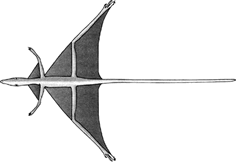
- New Scientist, 4 April 2006
The double delta planform is perfect for stable flight but, at about 5" wingspan, it will need some scaling up for Rapier L-1 |
||||||||||||||||||||||||||||||||||||||||||||||||||||||||||||||||||||||||||||||||||||||||||||||||||||||||||||
|
|
|
|||
|
The above piece of Pylonius-esque nonsense reminds me that duration models have been somewhat ignored of late, so I hope to redress the balance a little this month. First, Dick Twomey has sent this photo (right) of his latest project, which is named, in deference to his earlier Stiletto, ‘Swordsman’. Dick says he has since removed the cardboard tube for the motor, but that it hasn’t yet flown. Apart from the nasty plastic tail, this is a nice tissue-covered traditional build, and I hope Dick will draw up CAD plans for us on his new computer. Secondly, Laurence Marks, whose Boulton Paul P.111A was featured a couple of months ago, has provided a CAD plan and some details and of his latest Rapier powered duration designs: “My most successful models have been an R20 and my Phoenix 2 R30. The R20 flew incredibly well, […] and eventually disappeared into the distance towards Witney. Should have fitted a D/T! The R30 is a pretty traditional model, designed to look a bit like a glider from the fifties. It flies well – I got a second and third in the last couple of Dreaming Spires meetings – but it is too big. For this year, I am building an 85% version, which should make the climb more lively (a good climb seems to be the key to winning at Port Meadow, as there is some really strange air). I’m also reducing the dihedral to improve the turn. If anyone wants a plan (full size or 85%) then let me know.” 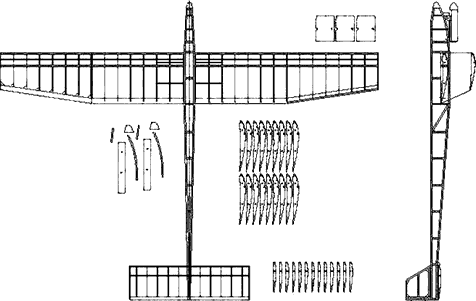
- Laurence Marks
Laurence adds that though Charlie Newman and Chris Strachan consistently manage the 90-120 sec max, “R30s lack the consistency of other FF competition classes, and flights of around a minute keep one at the sharp end of the table”. And thirdly, a French analogue of the Fizzel Fazzel. Pierre Claudy listed the ‘Planojet’ in his brief aeromodelling biography last month. This one was new to me, and, I suspect, to most readers, so here is a plan o’ the Planojet, tracked down by that arch-chasseur of French Jetex designs, John Miller Crawford. |

- Dick Twomey
Built-up wing with undercambered section, Depron tailplane, 21" wingspan, 44 g all up weight with Rapier L-4 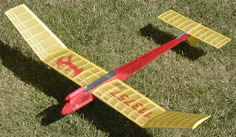 Laurence says his Phoenixes were designed to look like a ‘fifties glider’ and they do have a ‘Caprice-like’ look about them Note the position of the motor is similar to Dick Twomey’s Swordsman (above) 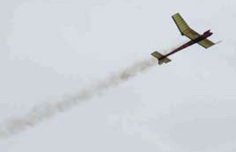 He has since made an 85% version to improve the climb. It is to be hoped that the new Rapiers will allow better consistency of performance
- Laurence Marks
|
|||
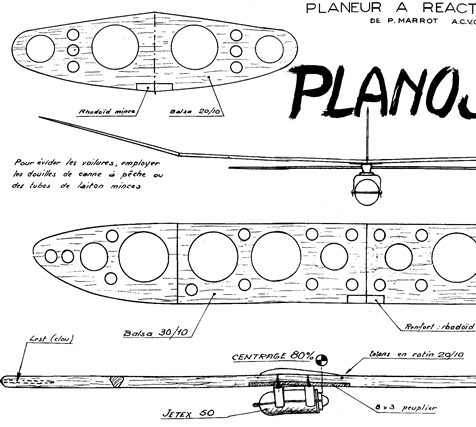 The design is credited to Monsieur P Marrot, who obviously looked to a Gruyère cheese for inspiration. John comments, “It was published in Modèle Magazine, May 1953. The text tells one to ‘cut out the holes in the flying surfaces, making use of fishing rod segments or thin-walled brass tubing’. I trust these were covered with tissue, though were no instructions to do so”. Given the success folk have had with vintage all-sheet designs powered by Rapiers, I see no reason why, like the Fizzel Fazzel, this shouldn’t go very well indeed. But do cover the holes.
The design is credited to Monsieur P Marrot, who obviously looked to a Gruyère cheese for inspiration. John comments, “It was published in Modèle Magazine, May 1953. The text tells one to ‘cut out the holes in the flying surfaces, making use of fishing rod segments or thin-walled brass tubing’. I trust these were covered with tissue, though were no instructions to do so”. Given the success folk have had with vintage all-sheet designs powered by Rapiers, I see no reason why, like the Fizzel Fazzel, this shouldn’t go very well indeed. But do cover the holes. |
|
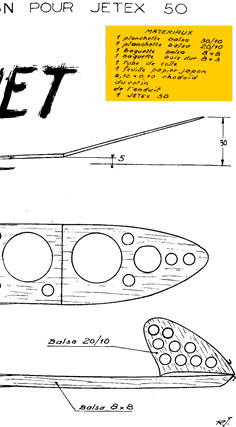
- Modèle Magazine, May 1953
|
||
Staying with our French theme, I received these period photos of a C/L ducted fan Leduc 021, built by Duncan Pepper in the late fifties. Dr Pepper recalls: “It was scaled up to 18" span from an AM three view [August 1956]. The main tube, a 4" diameter parallel tube of  If ducted fan free flight models were uncommon on the flying field, they were as rare as hens’ teeth in control line circles. Motive power was the main problem, as, despite claims made by some pundits, none of the commonly available low-revving diesels of the fifties was really up to the job. The Leduc 021 needed a Cox Olympic 15 at least, but all the teenage Duncan had was an ED Bee Mk II. He remembers, “it was woefully underpowered, and even with whipping it would not circulate […] still, it looked good in matt black!” Wimco Hollows The editor has lamented that there has been little about ‘solids’ in |
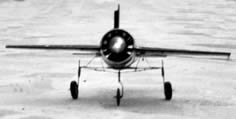  Duncan Pepper’s ambitious ducted fan Leduc 021 (1958/59) on its take-off dolly. Note the compression screw and needle valve of the pulley-started engine extend outside the fuselage.
- Duncan Pepper
|
|||
|
As related in an update to the online version of the July 2005 Smoky Addiction, Neil Smith, who sold his Penguin kit collection to the admirable Leif Hellstrom some time ago, was on safari in his loft when he made an unexpected discovery, about which he emailed me: “I was just clearing all my unmade kits and found a [Wimco] Canberra and Javelin; these were boxed, with only a couple of small bits missing. I have had them for years, and before I saw your article [July 2005] I had never met anyone else who had heard of them”. Neil, having ascertained that I am not a collector, auctioned the pair on eBay – but not before he had provided fine illustrations, three more of which are reproduced here. A couple of weeks later I was delighted to receive another email, this time from the buyer, Gerald Edwards, who was obviously delighted to add these rare models to his collection of FROG and Skybird models. Gerald commented “this is a poorly documented area” and was particularly struck by the colourful boxes (right and below), which are festooned with silhouettes of a number of 1950s jet aircraft. 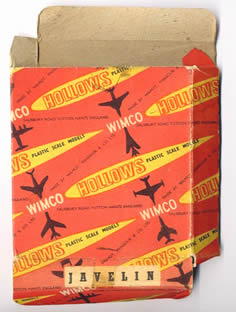
|
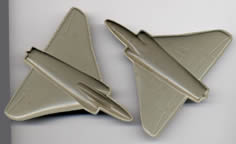
- Neil Smith

- Neil Smith
|
|||
|
|
||||
|
|
|
|||
|
|
|
|
|
|
|
|
Acknowledgements - Article: Roger Simmonds - Illustrations: Roger Simmonds, Pierre Claudy, MAAC archives via Bill Henderson, Laurence Marks, Duncan Pepper, Neil Smith, Dick Twomey |
|
|
|
|
ABOUT | MOTORS | MODELS | ARCHIVE | HISTORY | STORE | FAQ | LINKS |
|
|
Terms of Use
|
Queries? Corrections? Additions?
Please
contact us.
|
|